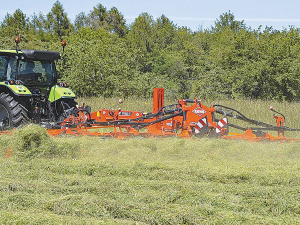Disc mower range gets upgrade
Kuhn has announced an expansion of its range of disc mowers, distributed by Norwood in New Zealand, with the addition of two new vertically folding rear mounted models, the GMD 3515 and GMD 4015.
 Kuhn claims its latest 13m wide tedder can be folded and ready for transport in 25 seconds – about half the time taken by its predecessor.
Kuhn claims its latest 13m wide tedder can be folded and ready for transport in 25 seconds – about half the time taken by its predecessor.
Machines with wider working widths have become a lot more common on the farm, particularly in the grass and hay production arena, where oversized rakes and tedders have helped to increase daily output dramatically.
In many cases the size of the machines dictate that they have complex hydraulic and mechanical systems to fold the machines from transport to work and back, while also eating up a surprising amount of time.
Grassland specialist Kuhn has addressed this latter issue with a redesign of its latest 13m wide tedder, allowing it to be ready for transport in 25 seconds – said to be about half the time taken by its predecessor.
The machine features a new single-movement folding mechanism which works directly off a tractor spool valve without needing any control box or electronic sensors.
Transport and storage are also improved thanks to a reduction in length to 6m, while a reversible drawbar allows it to be hitched to a greater variety of tractors.
The GF 13003T replaces the outgoing GF 1301 and offers operators improvements centred around new rotors, tines and the fast-fold system.
Still equipped with 12 rotors like the previous machine, internal upgrades are said to reduce wear, while the mounting system and improved contour following characteristics is said to reduce the
risk of soil contamination.
New 10mm diameter tines are equipped with springs that have increased from 70mm to 80mm diameter, that work in conjunction with an anti-tine loss system and hydraulic tine height adjustment to effectively double the expected lifespan of the previous tine format.
In operation, the weight of the chassis is supported by large transport wheels, while the small diameter rotors are suspended separately on individual wheel equipment, enabling each rotor to adapt to the ground contours, meaning soil contamination is reduced and tine tip wear is less severe.
A new levying body, currently with the working title of NZWool, has been proposed to secure the future of New Zealand's strong wool sector.
The most talked about, economically transformational pieces of legislation in a generation have finally begun their journey into the statute books.
Effective from 1 January 2026, there will be three new grower directors on the board of the Foundation for Arable Research (FAR).
The National Wild Goat Hunting Competition has removed 33,418 wild goats over the past three years.
New Zealand needs a new healthcare model to address rising rates of obesity in rural communities, with the current system leaving many patients unable to access effective treatment or long-term support, warn GPs.
Southland farmers are being urged to put safety first, following a spike in tip offs about risky handling of wind-damaged trees
President Donald Trump’s decision to impose tariffs on imports into the US is doing good things for global trade, according…
Seen a giant cheese roll rolling along Southland’s roads?